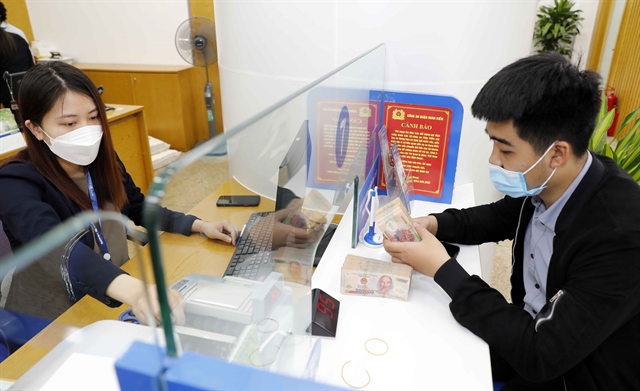 Economy
Economy


|
| A customer makes a withdrawal at a Vietcombank branch in Hà Nội. VNA/VNS Photo Trần Việt |
HÀ NỘI High demand during the Tết shopping season has prompted commercial banks to introduce credit offers worth hundreds of billions VNĐ for consumers, said industry experts and insiders.
In the last month, major banks including Vietcombank, ACB, TPBank, SHB, BIDV and consumer finance companies have been rolling out offers with incentives to individual customers.
Industry insiders said there was substantial demand for loans from the public, surpassing the previous year. However, they said it could also be attributed to a decline in income and an increase in unemployment. Despite the high demand, consumer finance companies are exercising caution in disbursing loans, particularly as debt defaults show no signs of improvement.
Since the end of the previous year, the State Bank of Vietnam (SBV) has issued directives urging credit institutions and bank branches to provide additional credit for individual consumption. The SBV emphasised the immediate implementation of solutions utilising data from the national population database to ensure safe and effective lending operations and enhance people's access to bank credit.
Nguyễn Quốc Hùng, secretary-general of the Vietnam Banking Association (VBA) said it has been a welcome change as consumer credit growth was at its lowest level in the past five years due to economic difficulties, declining incomes and increasing bad debts.
Experts and insiders, however, said a gradual recovery in domestic demand, leading to a resurgence in consumer credit is anticipated in 2024. Economist Nguyễn Hữu Huân, head of the Finance Market Department at the HCM City University of Economics, said solutions to the surplus liquidity in banks hinge on robust growth in three driving forces: domestic consumption, exports, and public investment.
While domestic consumer demand remains relatively weak, Huân suggested that reducing taxes and fees could contribute to boosting consumption. However, to stimulate consumer credit, the Government must adopt stronger policies, especially in the real estate sector, and measures to make housing more affordable.
Last year, private investment only saw a modest increase of 2.7 per cent, the lowest in the past decade, which had been typically growing by 12-14 per cent annually. Meanwhile, consumer demand saw a mere uptick of 3.52 per cent, with economic growth largely driven by Government spending.
Looking ahead to 2024, Hoàng Huy, an analyst at Việt Nam-based Maybank Investment Bank, said he anticipated a resurgence in domestic consumption as the primary driver of growth. This optimism will likely be fuelled by the revival of exports, more stable financial conditions for households, and a gradual recovery in the real estate market.
Experts said that consumer loans from banks, particularly those for home purchase and renovation, will outperform those of consumer finance companies, primarily due to the recent positive changes in the real estate market. Consumer finance companies were expected to face challenges as their primary customer base, those falling below the national income level, continued to grapple with financial difficulties.
"Consumer credit this year will face continued difficulties because borrowers are reducing demand, while lenders are more cautious due to increasing bad debt. Bad debts of consumer finance companies are rising rapidly, forcing them to be cautious in lending," said Professor Dr Đinh Trọng Thịnh.
Another impediment to the growth of consumer credit has been Việt Nam's lack of a robust legal framework to handle violations related to lending activities. Addressing this issue will be crucial for instilling confidence in banks and financial companies to lend more freely.
According to a recent survey of banks and financial institutions, handling bad debt in consumer lending is challenging due to the absence of collateral. Moreover, banks and financial institutions lacked the necessary manpower to handle thousands of small individual bad debts. To make matters worse, the traditional method of selling these debts in batches was no longer viable.
For instance, at BIDV, non-collateral bad debts for consumer loans account for less than 1 per cent of the total consumer loan balance. However, the sheer volume of loans, numbering in the thousands, complicated the recovery process due to a manpower shortage.
In practice, selling a portfolio of bad debts was deemed infeasible due to the absence of buyers in the market, given the small scale and lack of collateral of these loans. Additionally, credit institutions were prohibited by investment law from hiring debt recovery services. While debt recovery faces many challenges, legal proceedings and lawsuits are often prolonged and costly. VNS




